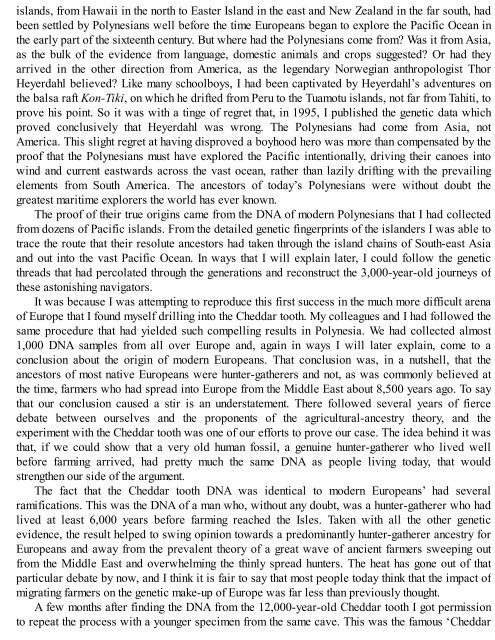Create successful ePaper yourself
Turn your PDF publications into a flip-book with our unique Google optimized e-Paper software.
islands, from Hawaii in the north to Easter Island in the east and New Zealand in the far south, had<br />
been settled by Polynesians well before the time Europeans began to explore the Pacific Ocean in<br />
the early part of the sixteenth century. But where had the Polynesians come from? Was it from Asia,<br />
as the bulk of the evidence from language, domestic animals and crops suggested? Or had they<br />
arrived in the other direction from America, as the legendary Norwegian anthropologist Thor<br />
Heyerdahl believed? Like many schoolboys, I had been captivated by Heyerdahl’s adventures on<br />
the balsa raft Kon-Tiki, on which he drifted from Peru to the Tuamotu islands, not far from Tahiti, to<br />
prove his point. So it was with a tinge of regret that, in 1995, I published the genetic data which<br />
proved conclusively that Heyerdahl was wrong. The Polynesians had come from Asia, not<br />
America. This slight regret at having disproved a boyhood hero was more than compensated by the<br />
proof that the Polynesians must have explored the Pacific intentionally, driving their canoes into<br />
wind and current eastwards across the vast ocean, rather than lazily drifting with the prevailing<br />
elements from South America. The ancestors of today’s Polynesians were without doubt the<br />
greatest maritime explorers the world has ever known.<br />
The proof of their true origins came from the DNA of modern Polynesians that I had collected<br />
from dozens of Pacific islands. From the detailed genetic fingerprints of the islanders I was able to<br />
trace the route that their resolute ancestors had taken through the island chains of South-east Asia<br />
and out into the vast Pacific Ocean. In ways that I will explain later, I could follow the genetic<br />
threads that had percolated through the generations and reconstruct the 3,000-year-old journeys of<br />
these astonishing navigators.<br />
It was because I was attempting to reproduce this first success in the much more difficult arena<br />
of Europe that I found myself drilling into the Cheddar tooth. My colleagues and I had followed the<br />
same procedure that had yielded such compelling results in Polynesia. We had collected almost<br />
1,000 DNA samples from all over Europe and, again in ways I will later explain, come to a<br />
conclusion about the origin of modern Europeans. That conclusion was, in a nutshell, that the<br />
ancestors of most native Europeans were hunter-gatherers and not, as was commonly believed at<br />
the time, farmers who had spread into Europe from the Middle East about 8,500 years ago. To say<br />
that our conclusion caused a stir is an understatement. There followed several years of fierce<br />
debate between ourselves and the proponents of the agricultural-ancestry theory, and the<br />
experiment with the Cheddar tooth was one of our efforts to prove our case. The idea behind it was<br />
that, if we could show that a very old human fossil, a genuine hunter-gatherer who lived well<br />
before farming arrived, had pretty much the same DNA as people living today, that would<br />
strengthen our side of the argument.<br />
The fact that the Cheddar tooth DNA was identical to modern Europeans’ had several<br />
ramifications. This was the DNA of a man who, without any doubt, was a hunter-gatherer who had<br />
lived at least 6,000 years before farming reached the Isles. Taken with all the other genetic<br />
evidence, the result helped to swing opinion towards a predominantly hunter-gatherer ancestry for<br />
Europeans and away from the prevalent theory of a great wave of ancient farmers sweeping out<br />
from the Middle East and overwhelming the thinly spread hunters. The heat has gone out of that<br />
particular debate by now, and I think it is fair to say that most people today think that the impact of<br />
migrating farmers on the genetic make-up of Europe was far less than previously thought.<br />
A few months after finding the DNA from the 12,000-year-old Cheddar tooth I got permission<br />
to repeat the process with a younger specimen from the same cave. This was the famous ‘Cheddar
















